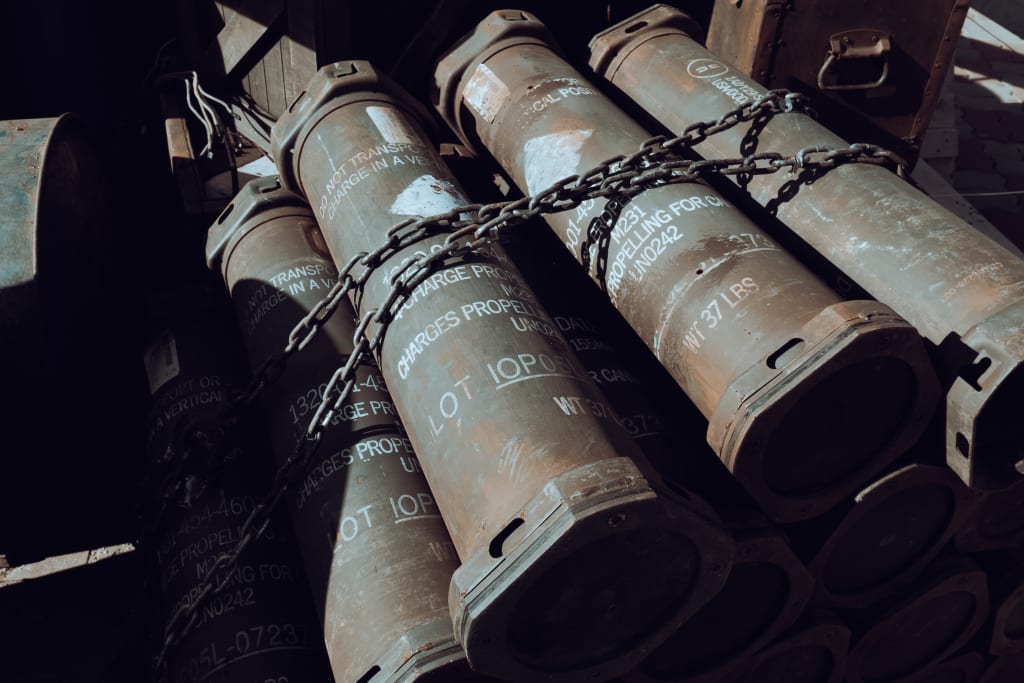Weapons of Destruction
A Look at the Most Lethal Tools of War

Nuclear Weapons:
Nuclear weapons are the most powerful weapons of mass destruction ever developed. These weapons derive their destructive power from nuclear reactions that release enormous amounts of energy. The first atomic bomb was developed during World War II and was dropped on the Japanese cities of Hiroshima and Nagasaki, causing massive destruction and loss of life (LINK 1). Since then, several countries have developed nuclear weapons, including the United States, Russia, China, and North Korea. The use of nuclear weapons has severe environmental and humanitarian consequences that can last for generations.
Chemical Weapons:
Chemical weapons are designed to cause harm or death through the use of toxic chemicals. These weapons can be delivered through various means such as bombs, shells, or aerosols(LINK 2). The effects of chemical weapons depend on the type of chemical used and the method of delivery. The use of chemical weapons is banned under international law, but they have been used in several conflicts throughout history, including the Iran-Iraq war, the Vietnam War, and the Syrian civil war.
Biological Weapons:
Biological weapons are designed to cause harm or death through the use of biological agents such as viruses, bacteria, or toxins. These weapons can be delivered through various means such as aerosols, water, or food. The effects of biological weapons depend on the type of agent used and the method of delivery (LINK 3). The use of biological weapons is banned under international law, but they have been used in several conflicts throughout history, including the use of anthrax spores by the Aum Shinrikyo cult in Japan in 1995.
Landmines:
Landmines are explosive devices that are designed to be buried in the ground and detonated when a person steps on them. Landmines can remain active for decades after they have been planted, making them a significant threat to civilians in conflict zones(LINK 4). Landmines have been used in several conflicts throughout history, including the Vietnam War, the Gulf War, and the wars in Afghanistan and Iraq. The use of landmines is banned under international law, but several countries continue to use them.
Cluster Munitions:
Cluster munitions are explosive weapons that contain multiple smaller submunitions, often called bomblets, that are released from a larger shell or canister. These submunitions are designed to scatter over a wide area and detonate upon impact, causing widespread damage and destruction.
Cluster munitions are typically delivered by aircraft or artillery, and they have been used in many conflicts around the world. They are often used to attack large concentrations of enemy forces, vehicles, or infrastructure.
One of the major concerns with cluster munitions is that many of the submunitions do not detonate upon impact, leaving behind unexploded ordnance that can remain dangerous for years or even decades after a conflict has ended. This can pose a significant threat to civilians and can make it difficult for communities to rebuild and recover after a conflict.
In response to these concerns, a number of countries and international organizations have sought to restrict or ban the use of cluster munitions. The Convention on Cluster Munitions, adopted in 2008, prohibits the use, production, stockpiling, and transfer of cluster munitions, and requires signatories to destroy existing stockpiles and clear areas contaminated by unexploded ordnance. As of 2021, 110 countries have joined the convention.
Incendiary Weapons:
Incendiary weapons are a type of weapon that are designed to set things on fire. They can be divided into two main categories: those that rely on chemical reactions to generate heat, and those that rely on mechanical means such as friction or compression.
Chemical incendiary weapons typically contain a mixture of chemicals that ignite in contact with air or moisture. They can be delivered in various forms, including bombs, shells, rockets, and grenades. The resulting fire can cause extensive damage and can be difficult to extinguish.
Mechanical incendiary weapons, on the other hand, rely on friction or compression to generate heat. Examples include tracer bullets and some types of grenades. These weapons can be particularly effective against targets that are difficult to ignite with chemical incendiaries.
The use of incendiary weapons is generally prohibited by international law under the Convention on Certain Conventional Weapons (CCW). The protocol on incendiary weapons, which entered into force in 1983, prohibits the use of incendiary weapons against civilians or civilian objects, as well as the use of air-delivered incendiary weapons against military targets located in civilian areas. However, there is some debate over whether certain types of incendiary weapons, such as white phosphorus, should be considered incendiary weapons or not. Incendiary weapons have been used in several conflicts throughout history, including World War II, the Korean War, and the Vietnam War (LINK 6). The use of incendiary weapons is banned under international law when used against civilians or civilian objects.
Fuel-Air Explosives:
Fuel-air explosives are explosive devices that use a combination of fuel and air to create a massive explosion. These weapons can be delivered through various means such as bombs or missiles (LINK 7). Fuel-air explosives have been used in several conflicts throughout history, including the Gulf War and the wars in Afghanistan and Iraq.
Directed-Energy Weapons:
Directed-energy weapons are weapons that use electromagnetic radiation to cause harm or damage. These weapons can be delivered through various means such as lasers, microwaves, or particle beams (LINK 8). Directed-energy weapons are still in the experimental stage and have not been widely deployed in conflicts. However, several countries, including the United States, China, and Russia, are investing heavily in their development.
Cyber Weapons:
Cyber weapons are tools or techniques used in cyber warfare, cyber-attacks, or espionage activities to infiltrate, compromise, or destroy digital systems or infrastructure. They can take various forms, including malware, viruses, ransomware, spyware, denial-of-service (DoS) attacks, and advanced persistent threats (APTs).
Cyber weapons can be used to steal sensitive information, disrupt critical infrastructure, disable military or government systems, and cause economic or physical damage. They can also be used for propaganda, psychological operations, and espionage purposes.
Cyber weapons can be developed and deployed by state-sponsored groups, criminal organizations, or individual hackers. They often exploit vulnerabilities in software, hardware, or human behaviour to gain unauthorized access or control over target systems.
The use of cyber weapons is considered a serious threat to national security, as they can cause significant harm and disruption to society. Therefore, the development, deployment, and use of cyber weapons are subject to international laws and regulations, such as the United Nations Charter, the Geneva Convention, and the Tallinn Manual on the International Law Applicable to Cyber Warfare. Cyber warfare has become an increasingly important aspect of modern conflicts, with several countries, including the United States, China, and Russia, investing heavily in their development.
Ballistic Missiles:
Ballistic missiles are long-range rockets designed to deliver a payload, such as a warhead, to a distant target. They are called "ballistic" because they follow a ballistic trajectory, which means that they are launched into the air and then follow a predetermined path through the atmosphere until they reach their target.
The basic design of a ballistic missile includes a warhead, a guidance system, a propulsion system, and a reentry vehicle. The warhead contains the explosive material that is intended to destroy the target, while the guidance system helps the missile to stay on course during its flight.
The propulsion system is responsible for launching the missile into the air and providing the necessary speed and altitude to reach its target. There are different types of propulsion systems used in ballistic missiles, such as solid-fuel rockets, liquid-fuel rockets, and hybrid rocket engines.
The reentry vehicle is designed to protect the warhead from the heat and pressure generated during reentry into the Earth's atmosphere. It typically includes heat shields, parachutes, and other mechanisms to slow down the missile and ensure a safe landing of the warhead.
Ballistic missiles can be classified into two types: intercontinental ballistic missiles (ICBMs) and shorter-range ballistic missiles. ICBMs have a range of more than 5,500 km (3,400 miles) and can travel across continents, while shorter-range ballistic missiles have a range of less than 1,000 km (620 miles) and are typically used for tactical purposes.
Ballistic missiles can carry a variety of payloads, including conventional explosives, nuclear warheads, chemical or biological agents, or other types of weapons. They have been used in warfare by various countries throughout history, and they continue to be a significant strategic weapon in modern warfare. Ballistic missiles are rockets that are designed to deliver a warhead over a long distance. These weapons can be launched from various platforms such as land, sea, or air. Ballistic missiles have been used in several conflicts throughout history, including the Gulf War and the wars in Afghanistan and Iraq (LINK 9). The use of ballistic missiles is regulated under international law, with several countries, including the United States, Russia, China, and North Korea, possessing nuclear-capable missiles.
Conclusion:
The development and use of weapons of destruction have had severe consequences for human life and the environment. The use of such weapons is regulated under international law, but several countries continue to possess and use them. The world must continue to work towards disarmament and non-proliferation of weapons of mass destruction to ensure global peace and security.
References:
Nuclear Threat Initiative. (2022). Nuclear Weapons. Retrieved from
(LINK 1) https://www.nti.org/learn/topics/nuclear-weapons/.
International Committee of the Red Cross. (2016). Chemical Weapons. Retrieved from
(LINK 2) https://www.icrc.org/en/document/chemical-weapons.
International Committee of the Red Cross. (2016). Biological Weapons. Retrieved from
(LINK 3) https://www.icrc.org/en/document/biological-weapons.
International Campaign to Ban Landmines. (2022). Landmine Monitor. Retrieved from
(LINK 4) https://www.the-monitor.org/en-gb/reports/2021/landmine-monitor-2021.aspx.
United Nations Office for Disarmament Affairs. (2019). Cluster Munitions. Retrieved from
(LINK 5) https://www.un.org/disarmament/wmd/cluster/.
United Nations Office for Disarmament Affairs. (2013). Incendiary Weapons. Retrieved from
(LINK 6) https://www.un.org/disarmament/wmd/incendiary/.
Stockholm International Peace Research Institute. (2022). SIPRI Yearbook 2022: Armaments, Disarmament and International Security. Retrieved from (LINK 7) https://www.sipri.org/publications/2022/sipri-yearbook/summary.
U.S. Department of Defense. (2020). Directed-Energy Weapons. Retrieved from
(LINK 8) https://www.defense.gov/Explore/Features/Story/Article/2255726/directed-energy-weapons-the-future-is-now/.
United Nations Office for Disarmament Affairs. (2022). Ballistic Missiles. Retrieved from
(LINK 9) https://www.un.org/disarmament/wmd/ballistic/.
About the Creator
Mogomotsi Moremi
Author and Web developer
Telling stories, one word at a time. Bringing worlds to life through my books and articles. #WriterLife #NeverGiveUp






Comments
There are no comments for this story
Be the first to respond and start the conversation.